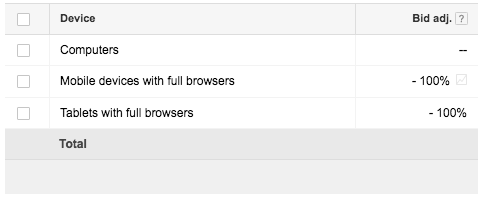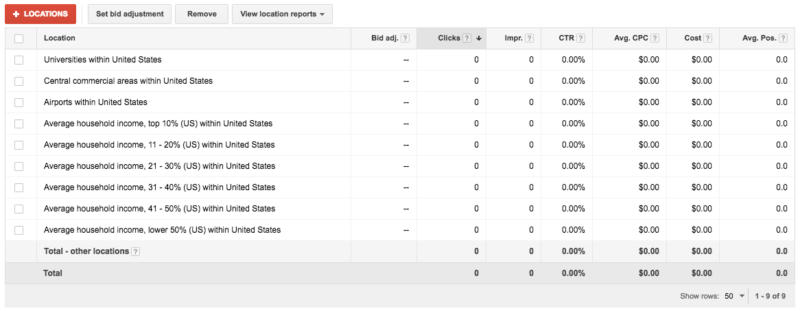The junior data scientist’s guide to AdWords search campaign structure: how to mine hidden gems for huge wins
In this helpful how-to, columnist Todd Saunders explains how to structure your AdWords account so as to glean useful insights about your target audience.
We all have 24 hours in a day, but each of us utilizes those hours differently. Similarly, all search engine marketers advertising on Google work with AdWords, but how we utilize it differs from advertiser to advertiser.
The most successful advertisers, like the most successful people, are those who utilize existing resources in the most effective way.
In AdWords, there are mountains of hidden data gems that require a bit of elbow grease and strategic campaign structuring to uncover. These rich pieces of data are essential to understanding your target market — and they are only available to you if you follow these key steps when setting up your AdWords campaigns.
Step 1: Device segmentation the right way
People behave differently on different devices. Now that we have tablet bid adjustments in AdWords, we can truly understand one of the most important factors for your campaign: how your ads perform on different devices.
Take action: Create three identical campaigns with the same budget. Name them as follows:
- Mobile – [Original Name]
- Desktop – [Original Name]
- Tablet – [Original Name]
For each campaign, set the bid adjustment of the other devices to -100%. (Here’s a walkthrough video for excluding devices.)
This segments your data into equal thirds, allowing you to isolate performance against device type. We’ll talk about what to do when you start seeing disparities in data across variables in the next section.
Caution: If you’re not spending more than $1,000 per month, this may split up your data too much, making it hard to make confident adjustments to the campaign.
Step 2: Prevent important customer data from slipping through the cracks
Remember what I said about free data? Well, here we go. Here’s how to mine essential location data in AdWords.
Understanding performance across audience income levels (targeting the US only)
One of the most important variables in AdWords influencing a person’s likelihood to buy is their income level, i.e., their ability to pay for your product or service.
Action: When setting up your campaigns, segment all your locations by Audience Income levels. By selecting each income level as a target, you will be able to compare how your campaign performs across six different income brackets:
- Top 10% income within the US
- 11% to 20%
- 21% to 30%
- 31% to 40%
- 41% to 50%
- Bottom 50% income levels in the US
Mining hidden location data for potential diamonds in the rough
For the most part, you can use AdWords’ robust reporting features to find niche audiences that convert well for you. Perhaps you’re selling Green Bay Packers apparel — you may find a niche community in Boulder, Colorado, full of die-hard Packer fans looking for apparel.
Essentially, you’re looking for groups of similar people with a potential affinity for what you’re selling.
There are three such groups in AdWords with HUGE upside:
Action: Layer universities, airports and commercial area targeting over your location settings.
By adding these targets to your campaign, you’re not adding NEW audiences — you’re creating segments of your targeting information to give you more opportunities to identify and monetize trends.
For example, if I want to target the entire United States (or a handful of specific states), I want to also target the universities, airports and commercial areas that fall within my intended targets. My locations will look like this:
Again, you aren’t targeting anyone new; you’re just gathering data on different segments of your audience. If you don’t do this from the start, you will not be able to retroactively retrieve this data.See? Free data!
Maybe you can’t find any correlation around these audience segments, but you never know — the data may tell a compelling story.
Step 3: Understand and analyze behavior around relevant daily schedules
One of the most powerful (and underutilized) adjustments in AdWords is changes based on ad schedule. Formally known as “day parting,” ad schedule bid adjustments allow you to control bids and prevent your ad from showing during certain times of day.
There’s an ad schedule report built into all your campaigns, but it’s separated day by day, hour by hour. That’s 24 hours multiplied by seven, or 168 data segments. That’s far too spread out to make inferences.
When you’re setting up your campaign, you can set 0% bids for certain time segments. Each will be specific to your business, but here are a couple we recommend:
- Weekdays versus weekends
- Segment by work shifts (first, second, third)
- Segment by key meal times (breakfast, lunch, dinner)
- Segment by business hours versus non business hours
- [Insert your hypothesis here]
Maybe all your conversions come from people staying up really late at night (1:00 a.m. to 5:00 a.m.). You might be able to tell by looking at your 168-item data. But it’ll be much much easier with your data segmented into a few well-defined chunks of time.
Final takeaway
This type of segmentation gives you a strong understanding of how your campaigns perform across major variables: Device, Location, Income Level and Time of Day. Without setting up some of these simple targeting methods beforehand, you may miss out on key data points about who your customer is.
You don’t need to think much further than the AdWords 101 approach to optimization:
- Gather the data — enough to make statistically significant decisions (more on AdWords testing here).
- Choose your key performance indicator (Impressions, Cost Per Click, Cost Per Acquisition) and compare that metrics across the variables listed above.
- Make the necessary campaign adjustments to capitalize on the trends you’ve analyzed. You can move your budget away from poor performers towards whatever variable is driving the most returns.
Do you have question about this process? Hit me up on social media!
Opinions expressed in this article are those of the guest author and not necessarily Search Engine Land. Staff authors are listed here.
Related stories


